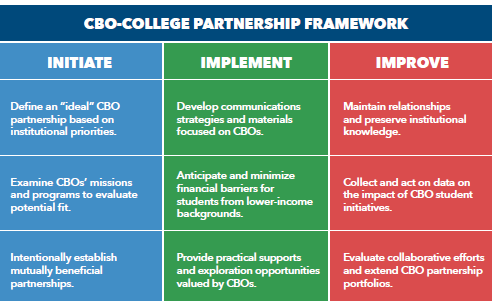One day last summer, amid campus tours, academic enrichment programs, and preparations for the fall, a group of talented high school students from across the country navigated the sprawling campus of the University of Michigan in Ann Arbor. During their visit, they immersed themselves in the college experience, built connections with students and faculty, and engaged in specialized academic enrichment and admissions workshops.
This was not just a standard campus visit, but rather one part of a multiyear series of opportunities that College Horizons offers to ensure the students they serve— primarily those from Native American, Alaska Native, and Native Hawaiian backgrounds—overcome imposing educational access and attainment gaps. Community-based organizations (CBOs) like College Horizons are leading efforts across the country to connect talented young people from lower-income and first-generation backgrounds as well as communities of color to higher education. Their efforts are reinforced by a commitment from institutions like the University of Michigan to expand access to postsecondary opportunity.
Now, as higher education navigates unprecedented changes, both colleges and CBOs must determine how to ensure those students can still realize those opportunities. One thing is for certain: It is more important than ever that colleges and CBOs unite to reimagine the pathways to postsecondary education so that far more students can enroll in institutions where they will thrive. The promise of that partnership is the basis for Better Together, a report published today by College Greenlight and the American Talent Initiative.
Throughout this report, we draw on the expertise of our collective networks—College Greenlight’s national ecosystem of more than 1,500 CBO partners and the American Talent Initiative’s coalition of 131 high-graduation-rate colleges and universities—to make the case for this collaboration and detail how to leverage its promise through an actionable partnership development framework.

With additional insight from case studies that highlight how the University of Michigan and the University of Richmond cultivated and scaled their CBO partnership development strategies, public and private institutions across the country can take steps to be better together.
Why Better Together?
For young people with limited postsecondary exposure at high schools where they are likely to get only a small fraction of a guidance counselor’s attention, the already complex college application process is even more daunting. CBOs can often bridge the counseling and advising gaps those students face by building relationships with them as early as middle school, helping them navigate through onerous admissions and financial aid processes. Because of this years-long engagement, CBOs emerge as trusted partners for students from lower-income and first-generation backgrounds as well as communities of color. They have the power to connect students to colleges they deserve to attend but often are not aware of.
This report illustrates how CBOs can serve a similar role for colleges and universities, providing pipelines to the talented students from underrepresented backgrounds that institutions have long sought to reach. After all, research continues to illustrate CBOs’ ability to increase academic engagement, applications for financial aid, and postsecondary enrollment rates among the young people that they serve.
How Do They Become Better Together?
While many postsecondary institutions currently engage with CBOs to recruit students from underserved or hard-to-reach communities, we found the nature of their collaborations vary widely. While some partnerships are more ad hoc, defined by the occasional high school visit or admissions workshop, others may represent more structured collaborations, guided by a memorandum of understanding and/or set of indicators to track the success of their engagement.
The partnership framework included in this report is designed to offer a template for meaningful engagement between institutions and CBOs, driven by two guiding questions:
- How might colleges and universities better serve students and their families via CBOs?
- How might these partners create a sustainable process for evaluating CBO and college relationships for long-term student fit and success?
The impact of that collaboration hinges on each entity taking steps to not only define the parameters of the partnership and put those into practice, but also institutionalize and sustain investments in this work. As institutions and CBOs embark on their partnership development work, they can proceed through the following stages:
- INITIATE: Determine if your visions for a successful partnership align; if they do, identify the respective strengths you each can contribute to execute on that vision and outline the ways in which you can support one another.
- IMPLEMENT: Prioritize ongoing communications to identify the supports that students from partner CBOs need to effectively navigate the admissions process and structure experiences that they would need to excel at the institution.
- IMPROVE: Continually report progress against measures established at the outset of the partnership that reflect its effectiveness; ensure that these are codified in departmental strategy documents and included in any related staff transition and onboarding documents.
For details on associated best practices that institutions can implement to realize these goals, read the report here.
What Comes Next in our Efforts to be Better Together?
As postsecondary institutions and CBOs unite in an effort to increase college access and attainment, the question remains as to how they can reinvent pathways to higher education for talented students from lower-income and first-generation backgrounds as well as communities of color. Instead of “fly-ins,” events where students come to campus from around the country, admissions officers are preparing virtual tours, positioning current students for video chats, and redesigning other CBO events for a virtual context. In place of high school visits and college fairs, institutions can structure more tailored workshops as students and families navigate financial aid and admissions forms. In fact, this might be an opportunity to more effectively reach students from hard-to-reach communities that admissions officers have traditionally been unable to visit.
Amid the dizzying array of changes that institutions and CBOs will navigate this fall, one thing is clear: They will be able to serve students better together.
To access the report, accompanying executive summary, and more information about the American Talent Initiative and College Greenlight, click here.
